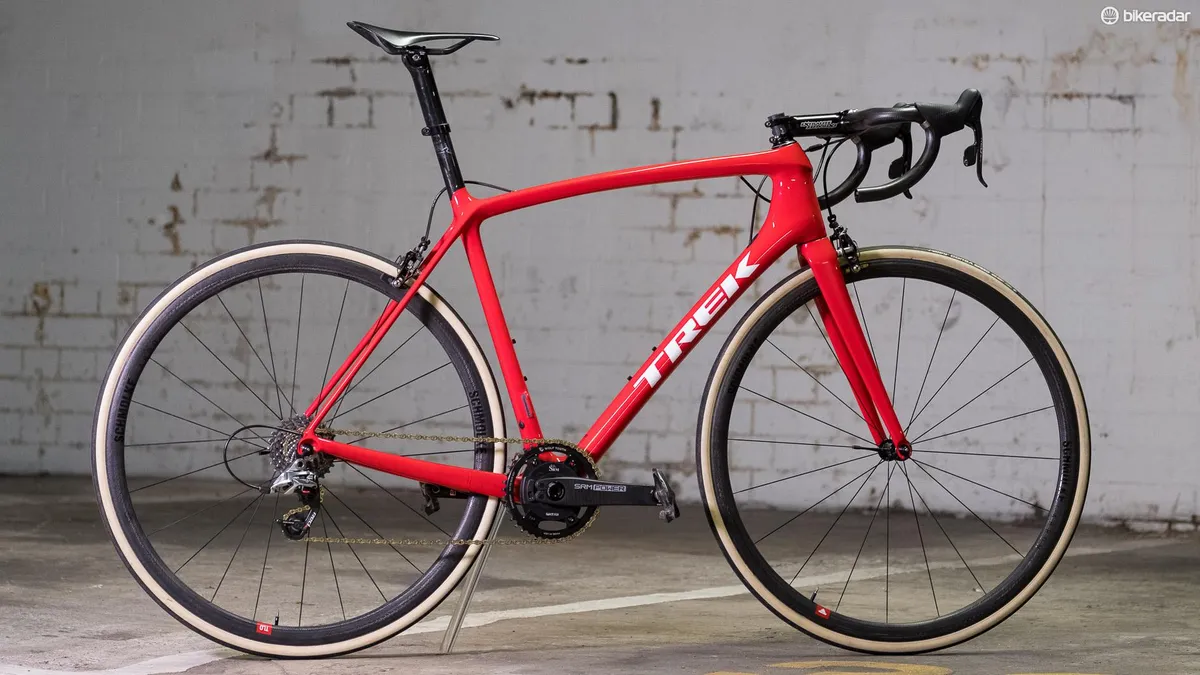Trek is waving farewell to the Émonda – a dedicated lightweight bike that’s been a staple of its line-up since 2014 – with the new Madone.
This new aero all-rounder road bike is claimed to be as aero as the previous-generation Madone and as light as the Émonda.
So why did Trek kill off the Émonda?
“I would rephrase that question a little bit,” says Jordan Roessingh, Trek’s director of road bikes and Project One.
“We merged the two platforms into one… as, through the entire development process, we found it would be much harder to make an Émonda only incrementally lighter, [but making it more aero] would make it much faster.
“It’s the same story for the Madone, where we could make it incrementally faster, or dramatically lighter.
“Merging the performance of the Émonda and Madone offered the biggest benefit to riders, versus staying with the existing families.”

While the previous-generation Émonda, launched in 2021, made some concessions to aero performance, it was still ostensibly a climber’s bike, prioritising low weight and stiffness.
Is there no space for a dedicated climber’s bike in 2024? Roessingh concedes that “riders generally really like how a lightweight bike feels”.
“They pick it up and it's a very easy number to measure for themselves versus aerodynamic performance.”

However, he argues “you can’t have a super lightweight bike… without any aerodynamic consideration and expect that to be a performance road bike.
“This merger and consideration of [aero and weight] is the modern view on road racing bikes – both are really important, but you can't just discretely focus on one.
“Even if you’re looking at really steep climbs, aero performance always matters – and even then it only matters a little bit in terms of pure speed.”
Material advances continue to push bike design

Advances in design and manufacturing have made it possible for an aero bike to approach the weight of a climbing bike.
Trek’s new OCLV 900 layup, which uses a new manufacturing process, helps reduce weight in complex areas such as the IsoFlow junction – the hole around the seat cluster that’s claimed to improve aero performance and comfort – explains Adam Bird, a design engineer for Trek.

“Computing advances and advances in CFD [computational fluid dynamics] enabled us to churn through early concepts – it’s way above and beyond what we were able to do before,” adds Bird.
The continued development of electronic groupsets has also opened up frame design for engineers.
“Wireless shifting means you don’t have to worry as much about how difficult it is to work on a bike – tight bends or curves don’t matter when you’re routing a hydraulic hose,” explains Jake Glahn, Trek’s bike marketing coordinator.
“That lets us do more and more with our bikes.”
Will the Émonda become Trek’s Aethos? Probably not

Specialized made a similar move to Trek when it discontinued its Venge aero bike, focusing development on the Tarmac, which is now its sole road race bike platform.
However, Specialized unexpectedly turned back the clocks in 2020 with the Aethos, an uncompromisingly light, round-tubed climbing bike that eschewed aero tech altogether.
Although nothing can be ruled out, it feels unlikely Trek will follow suit with a reintroduced lightweight Émonda (or a new platform altogether).
As reported by Bicycle Retailer and Industry News in March, Trek president John Burke said that, by 2026, Trek would reduce SKUs by 40 per cent.
Though hill climbers will shed a tear, even a limited run of boutique Émonda framesets wouldn’t make sense for a company looking to reduce inventory levels.
The days of ultra-niche short-run bikes, such as the Trek District Carbon, are, most likely, over.
Young riders push development

Outside of wider business strategy, Roessingh says Trek’s work with Team Lidl-Trek “significantly” informed its decision to merge both platforms.
“[Our riders] are really open with telling us about what they think about our products.
“One of the things that consistently came up in all of those conversations was… the need to choose between two platforms.
“They loved the Émonda and they loved the Madone, but the added complexity of deciding ‘which bike do I race on?’ was a significant stressor for them.”
However, although the benefits of aero tech are well understood, many pros struggled to shake off their inner weight weenie.
Even in the face of evidence, it was common to see riders turning to old tricks to keep weight down until very recently, or even riding lightweight climbing bikes for flat stages.

However, Roessingh says younger riders’ acceptance of aero tech and new ideas also pushed Trek towards an all-in-one road bike platform.
“The younger riders are much more receptive to innovation and trying new things than the previous generation,” he explains.
“We can bring those concepts, like aero water bottles or flared handlebars, and they’re receptive to them.
“From a bike manufacturer process, this means we’re able to push [development] faster when, 10 or 15 years ago, they would have just said no.”
Roessingh believes tech trends in pro racing still influence consumer buying habits – the mainstream adoption of larger-volume tyres and narrower handlebars are the two most widely visible trends, he says.
“They see someone winning the Tour on a bigger-volume tyre and they think ‘okay, this could work for me, it’s not going to slow me down’.
“The lightest, fastest bike is the solution for everybody.”





